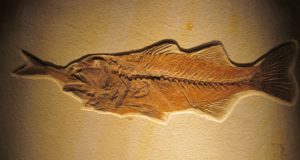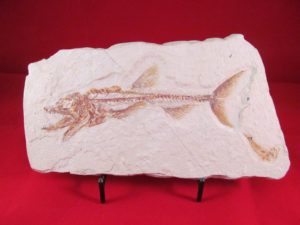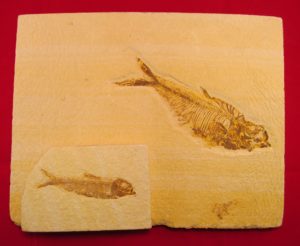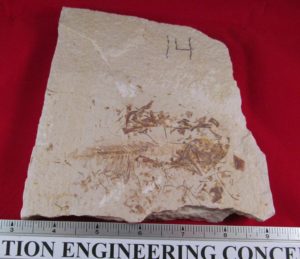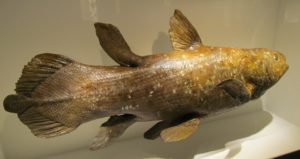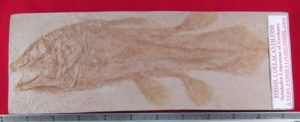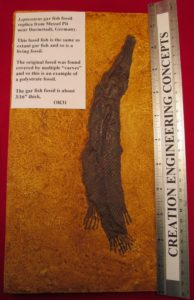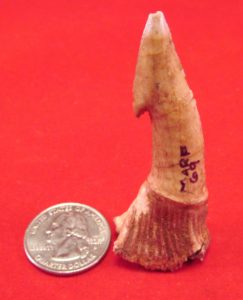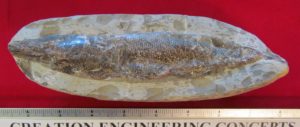All fossil images and descriptions ©2017 all rights reserved. Contact us for permission policy.
Fish Eating Fish
Description: In the lower figure the largest fish is Euripholis boissieri and is 5 3/4″ long. It was buried eating a small unknown type of fish. The third 1 1/4″ long fish at lower right is also unknown. The Euripholis is commonly called the “Lebanese Viper Fish.” Identifying features of this fish are its teeth and characteristic fins and tail.
Upper figure is a photo of a “fish aspiration” fossil on display at the Houston Museum of Natural Science. Eating fish is Diplomystus while eaten fish is Mioplosus.
Location: Euripholis from Lebanon Diplomystus and Mioplosus from the Green River formation of Wyoming.
Interpretation: The Euripholis is a “Lagerstatte” (well-preserved) fossil that must have been preserved by rapid and total burial during the global Flood. The burial was so rapid that the one fish was “captured” in the matrix in the process of swallowing the other fish. This is a relatively uncommon fossil finding, yet thousands of such fossils have been found.
The near perfect “fish eating fish” fossilized display at the Houston Museum of Natural Science shows another example of this phenomenon. The Houston museum panel explanation reads, “Fish choked to death swallowing another fish.” So, according to the secular explanation, these fish choke to death and then slowly sink to the lake floor to be gradually covered by sediment over many years of time. There is nothing about this explanation that matches reality!
#MARF33
Fish Knightia and Diplomystus
Description: The Knightia fish fossil (left) is 3 5/8″ long X 13/16″ wide and the Diplomystus fish fossil is 6 1/2″ long X 2″ wide. Both are a form of herring fish.
Location: Green River formation of Wyoming.
Interpretation: Untold millions of these fish were buried in the limestone deposits near Kemmerer, Wyoming by the action of the Genesis Flood. These fossil fish represent some of the more common life forms found in the rock layers of that area.
These fish are just as complex in design and construction as present day herring fish, thus there is no evidence of evolution other than variation within created kinds. There are many similarities between the sedimentary rock layers of Wyoming where these fish were buried and those at Solnhofen in Germany where Archaeopteryx and many other delicate fossils have been discovered. The Genesis Flood was a worldwide cataclysm as described in the Bible, as attested to by the proper interpretation of these fossils.
#MARF25 and MARF2
Fish Priscacara
Description: Fossil fish is 4 3/4″ long X 2 3/4″ wide. The fin and skeletal details of this fish are very visible in this specimen.
Location: Green River formation of Wyoming.
Interpretation: Fossil fish Priscacara appears like today’s perch, and is categorized as such by some experts. Evolutionists believe that the “18 inch” layer from which this fossil was recovered represents about 4,000 years of depositional time. If this is correct, then each year would represent a thickness of only 4 1/2 thousandths of an inch, or about the thickness of two human hairs!
Fish and other fossils found in the 18 inch layer have been flattened by the weight of overburden above them, yet still have thicknesses of at least 1/8 inch. If the depostional rate of 4 1/2 thousandths of an inch per year is correct it would have taken 28 years for the deposits to cover the fish. How could the fish remain preserved for even a portion of this length of time? The secular hypothesis is unreasonable. This fish and the other life forms trapped in the 18 inch rock layer were more likely rapidly and completely buried in the worldwide Flood, a watery catastrophe with no equal!
#MARF65
Exploded Fish
Description: The exploded fish consists of most of the skeletal parts of a living fish. The area with the fish remains is about 5″ wide X 4″ high.
Location: Green River formation of Wyoming.
Interpretation: This fossil and others like it are strong evicence that the fish remains were rapidly and completely buried, and supports the biblical creationist worldview. Experiments and observations of dead fish today indicate that they decay within days or weeks at most. In the same Green River formation limestone layers are also found untold numbers of coprolite (fossil poop) samples frozen as fossils. Due to the bacteria content this material would normally decay in a matter of hours. The secular uniformitarian explanations of slow deposition over millions of years for these fossils do not match reality.
#MARF28
Fish Coelacanth
Description: The fossil replica Coelacanth in the lower figure is 4″ wide X 11″ long with two fins below and two fins above visible in the matrix. The photo above is of a model of an extant Coelacanth “living fossil” fish at the Houston Museum.
Location: Solnhofen limestone of Bavaria, Germany.
Interpretation: When the Coelacanth was first discovered as a fossil in the rock record it was described by evolutionists as a fish that had lobed fins that were evolving into legs so it could eventually walk on land. That story matches the evolutionary idea that land animals evolved from fish. Many years later in the 1930s, Coelacanth fish were found alive and well in the Indian Ocean. Since then many other of these famous fish have been found alive. The living fish use their fins to swim and there is absolutely no evidence the fins are changing into legs. These fish are another example of a living fossil and are strong supporting evidences for the Genesis Flood and against evolution and millions of years.
#OR5
Gar Fish Lepisosteus
Description: The Lepisosteus gar fish replica fossil is 1 3/4″ wide X 9 1/4″ long X 3/16″ thick.
Location: Messel Pit near Darmstadt, Germany.
Interpretation: Gar fish of today are recognized by their tightly-packed, diamond-shaped scales and their characteristic toothy nose. Fossil gar fish, like the juvenile in the figure above, look pretty much the same as the extant fish. There is little change over the evolutionists’ imagined fifty million years of progress. Therefore gar fish are another example in the living fossil category.
This fossil fish is at least 3/16″ thick even after having been flattened under tons of sediments. It was buried by a large number of sedimentary varves (thin layers). That means we can categorize this living fossil as a polystrate fossil as well. Both living and polystrate fossils do not mesh well with the secular worldview of evolution and deep time. The biblical creationist view is shown to be superior time and again by true science.
#OR31
Onchopristus Sawfish
Description: The Onchopristus fossil tooth is 2 1/2″ long and 1″ X 3/8″ at its root. The tooth length minus root length is 1 3/4″ and the barb is located 7/8″ from the pointed end of the tooth.
Location: The Tegana formation of the Kem Kem beds of Morocco.
Interpretation: The Onchopristus was a sawfish very similar to the sawfish existing today. The many teeth (denticles) extending from its long rostrum indicate that it would have been a fearsome predator, and it is known to have grown to be over 26 feet long. The fossils found from this fish are usually limited to the barbed teeth and the rostrum since its body was made up of cartilage like rays and sharks, and cartilage does not easily fossilize.
Since modern-day sawfish use the rostrum as their primary sensing mechanism, it is probable that Onchopristus had the same ability. The barbs in the teeth that lined the up to 8 feet long rostrum undoubtedly were designed to facilitate retaining any fish impaled on the sawfish’s nose.
#MARF69
Rhacolepsis Fish
Description: The Rhacolepsis fish fossil is 7 3/4″ long X 1 3/8″ wide in a nodule 7 3/4″ long X 2 1/2″ wide X 1 1/2″ thick. If one clicks on the image twice, the detail of the scales can be clearly seen.
Location: The Santana formation of northeast Brazil.
Interpretation: This type of fish fossil from this location is famous because complete fossilized hearts have been recovered and studied using CT scanning procedures. These studies indicated that Rhacolepsis had a prominent heart chamber with five internal valves. This design is different from the design of extant fish. While secular scientists assume that the current design must have evolved over millions of years from the Rhacolepsis design, they have no idea how this occurred. The evolutionary path for this transformation is totally missing from the fossils!
The biblical creationist would assume that it is possible, even likely, that God chose in the beginning to create fish with differing heart designs. It could be that Rhacolepsis is found today only in the rock record because it did not survive the global Flood, or was not able to adapt to the environmental conditions that existed after the Flood.
#MARF100
ORDER THE FOSSIL BOOK:
